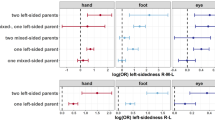Abstract
As an alternative to genetic theories of handedness, some theorists have offered an environmental mechanism, associated with birth stress, for the appearance of left-handedness. They suggest that brain damage as a result of birth difficulties can lead to a switch in hand preference from the right side to the left side. Consequently, one should find more left-handers in groups where the probability of the occurrence of birth stress is greater. Three studies are presented which explore the laterality of not only hand but also foot, eye, and ear, in a total of 5161 individuals, in an attempt to assess any relationship to birth stress. Maternal age seems to predict deviations from dextrality, dependent on the sex of the offspring, while paternal age and birth order do not. The use of a direct measure of conditions predisposing toward birth stress suggests that these results depend on prenatal or perinatal environmental trauma rather than chromosomal factors.
Similar content being viewed by others
References
Annett, M. (1972). The distribution of manual asymmetry.Br. J. Psychol. 63:343–358.
Annett, M. (1973). Handedness in families.Ann. Hum. Genet. London 37:93–105.
Annett, M. (1978). Genetic and non-genetic influences on handedness.Behav. Genet. 8:227–249.
Bakan, P. (1971). Handedness and birth order.Nature 229:195.
Bakan, P. (1977). Left-handedness and birth order revisited.Neuropsychologia 15:837–839.
Bakan, P. (1978). Why left-handedness?Behav. Brain Sci. 2:279–280.
Bakan, P., Dibb, G., and Reed, P. (1973). Handedness and birth stress.Neuropsychologia 11:363–366.
Blau, A. (1946).The Master Hand, American Orthopsychiatric Association, New York.
Broman, S. H., Nichols, P. L., and Kennedy, W. A. (1975).Preschool IQ: Prenatal and Early Developmental Correlates, Lawrence Erlbaum Associates: Hillsdale, N.J.
Clark, M. M. (1957).Left-Handedness: Laterality Characteristics and Their Educational Implications, University of London Press, London.
Collins, R. L. (1975). When left-handed mice live in right-handed worlds.Science 187:181–184.
Collins, R. L. (1977). In Harnard, S., Doty, R. W., Jaynes, J., Goldstein, L., and Krauthamer, G. (eds.),Lateralization in the Nervous System, Academic Press, New York, pp. 137–150.
Coren, S., and Porac, C. (1977). Fifty centuries of right-handedness: The historical record.Science 198:631–632.
Coren, S., and Porac, C. (1978). The validity and reliability of self-report items for the measurement of lateral preference.Br. J. Psychol. 69:207–211.
Coren, S., Porac, C., and Duncan, P. (1978). Life-span age trends in laterality. Paper delivered at Psychonomic Society meeting, San Antonio, November.
Coren, S., Porac, C., and Duncan, P. (1979). The behavioral validation of a self-report inventory to assess four types of lateral preference.J. Clin. Neuropsychol. 1:55–65.
Court Brown, W. M., Jacobs, P. A., Buckton, K. E., Tough, I. M., Kuenssberg, E. V., and Knox, J. A. F. (1966).Chromosome Studies on Adults, Eugenics Laboratory Memoirs, No. 42, Cambridge University Press, London.
Court Brown, W. M., Jacobs, P. A., and Tough, I. M. (1967). Some types of information obtainable from chromosome studies on defined population groups. InHuman Radiation Cytogenics: Proceedings of an International Symposium Held in Edinburgh, 12–15 October 1966, Wiley, New York, pp. 115–121.
Falek, A. (1959). Handedness: A family study.Am. J. Hum. Genet. 11:52–62.
Ferreria, A. J. (1969).Prenatal Environment, Thomas, Springfield, Ill.
Hecaen, H., and De Ajuriaguerra, J. (1964).Left-Handedness: Manual Superiority and Cerebral Dominance, Grune & Stratton, New York.
Hicks, R. A., Evans, E. A., and Pellegrini, R. J. (1978). Correlation between handedness and birth order: Compilation of five studies.Percept. Mot. Skills 46:53–54.
Hubbard, J. I. (1971). Handedness is not a function of birth order.Nature 232:276–277.
Lesinski, J. (1975). High risk pregnancy: Unresolved problems of screening, management and prognosis.Obstet. Gynecol. 46:599–603.
Levitan, M., and Montagu, A. (1971).Textbook of Human Genetics, Oxford University Press, New York.
Levy, J., and Nagylaki, T. (1972). A model for the genetics of handedness.Genetics 72:117–128.
Matsunaga, E. (1973). Effect of changing parental age patterns on the chromosomal aberrations and mutations.Soc. Biol. 20:82–88.
Montagu, A. (1962).Prenatal Influences, Thomas, Springfield, Ill.
Polednak, A. P. (1976). Paternal age in relation to selected birth defects.Hum. Biol. 48:727–739.
Porac, C., and Coren, S. (1976). The dominant eye.Psychol. Bull. 83:880–897.
Porac, C., and Coren, S. (1978). Relationships between lateral preference behaviors in humans.Behav. Brain Sci. 2:311–312.
Porac, C., and Coren, S. (1979). Individual and familial patterns in four dimensions of lateral preference.Neuropsychologia 17:543–548.
Porac, C., Coren, S., Steiger, J. S., and Duncan, P. (1980). Human laterality: A multidimensional approach.Can. J. Psychol. 34:91–96.
Raczkowski, D., Kalat, J. W., and Nebes, R. (1974). Reliability and validity of some handedness questionnaire items.Neuropsychologia 12:43–48.
Satz, P. (1972). Pathological left-handedness: An explanatory model.Cortex 8:121–135.
Satz, P. (1973). Left-handedness and early brain insult: An explanation.Neuropsychologia 11:115–117.
Schwartz, M. (1977). Left-handedness and high-risk pregnancy.Neuropsychologia 15:341–344.
Selvin, S., and Garfinkel, J. (1972). The relationship between paternal age and birth order with the percentage of low birth-weight infants.Hum. Biol. 44:501–510.
Author information
Authors and Affiliations
Additional information
This research was supported by grants from the Medical Research Council of Canada and from the Natural Sciences and Engineering Research Council of Canada, and represents an equal and shared contribution of both authors.
Rights and permissions
About this article
Cite this article
Coren, S., Porac, C. Birth factors and laterality: Effects of birth order, parental age, and birth stress on four indices of lateral preference. Behav Genet 10, 123–138 (1980). https://doi.org/10.1007/BF01066263
Received:
Accepted:
Issue Date:
DOI: https://doi.org/10.1007/BF01066263




